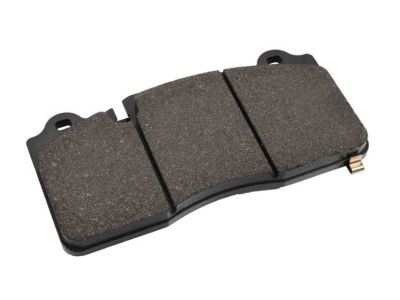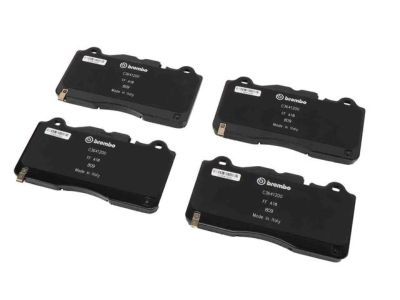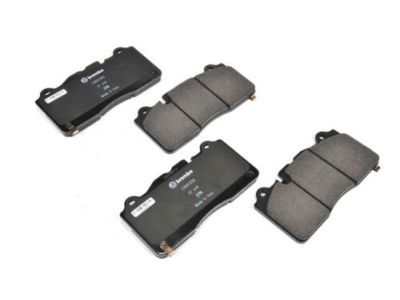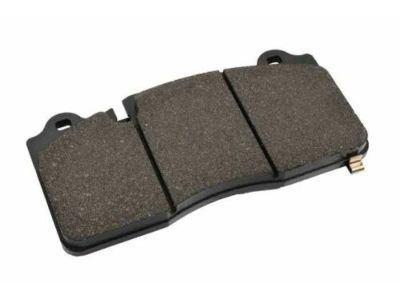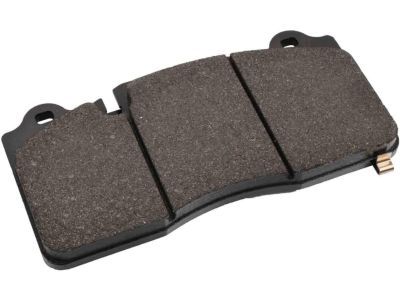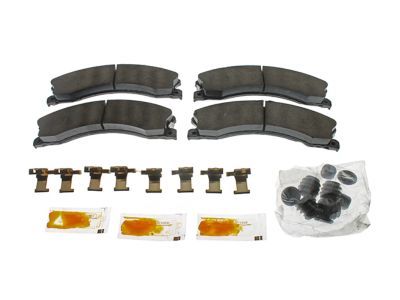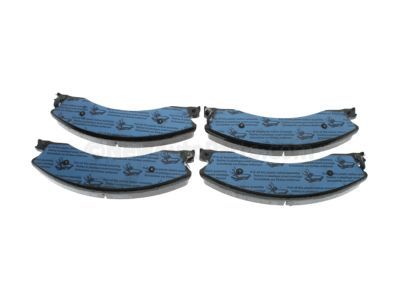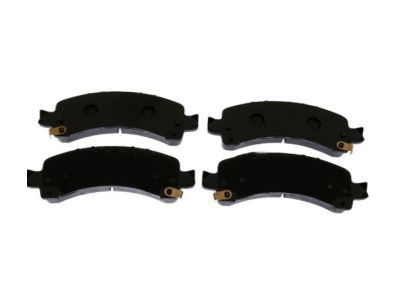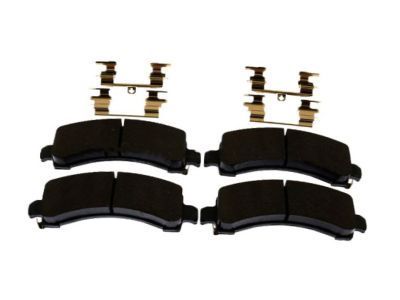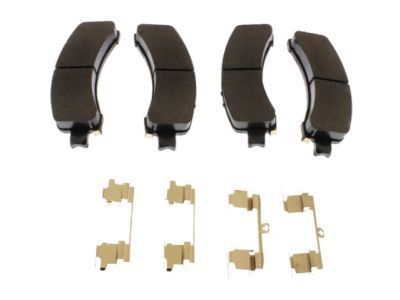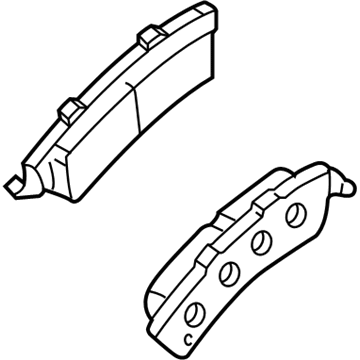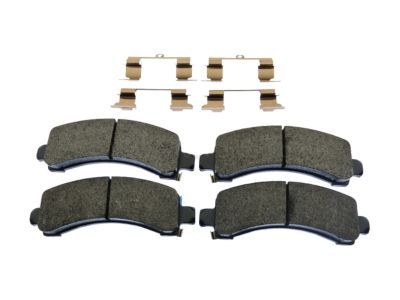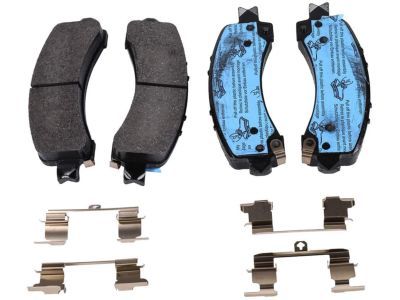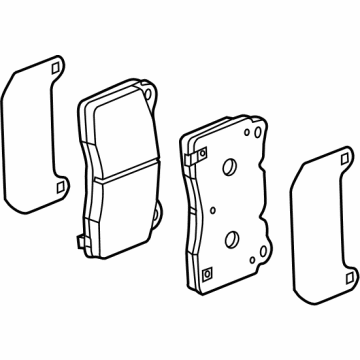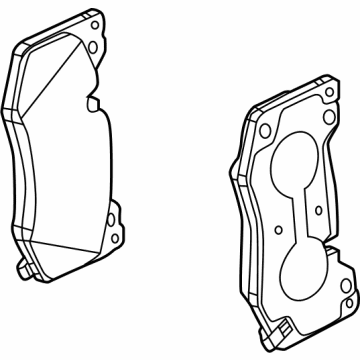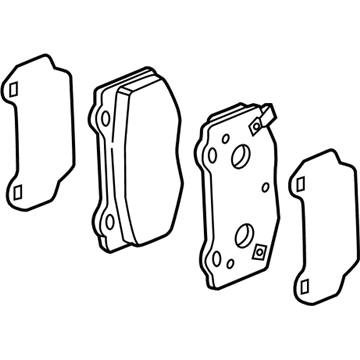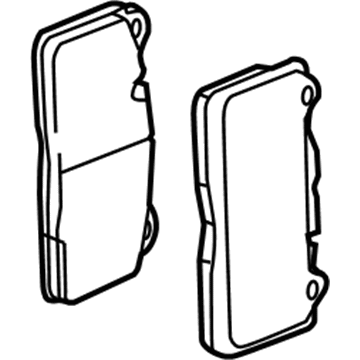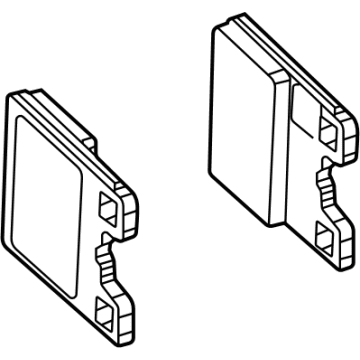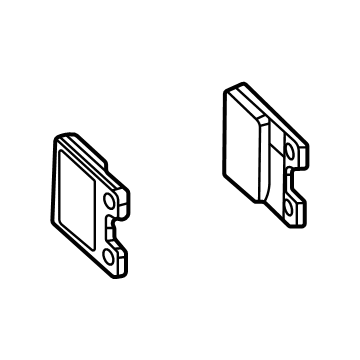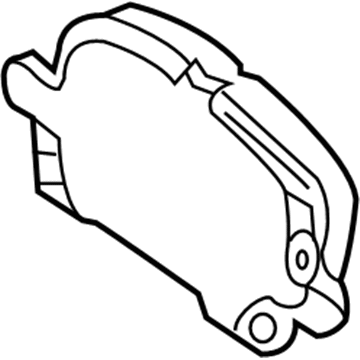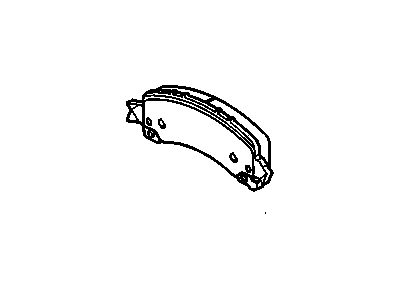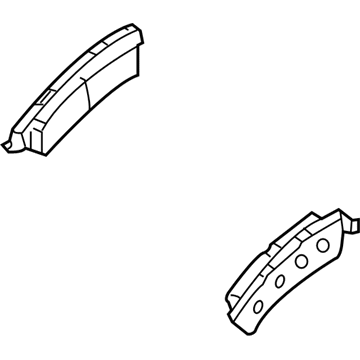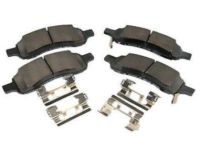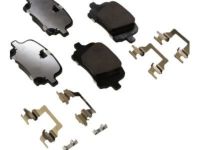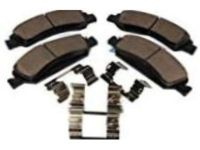ChevyParts
My Garage
My Account
Cart
OEM Chevrolet Brake Pad
Disc Brake Pad Set- Select Vehicle by Model
- Select Vehicle by VIN
Select Vehicle by Model
orMake
Model
Year
Select Vehicle by VIN
For the most accurate results, select vehicle by your VIN (Vehicle Identification Number).
245 Brake Pads found

Chevrolet Brake Pads Part Number: 23399101
$310.07 MSRP: $607.07You Save: $297.00 (49%)Ships in 1-2 Business DaysProduct Specifications- Other Name: Pad Kit, Brake; Disc Brake Hardware Kit; Front Pads
- Position: Front
- Replaces: 23337277

Chevrolet Brake Pads Part Number: 20829195
$125.60 MSRP: $263.16You Save: $137.56 (53%)Ships in 1-3 Business DaysProduct Specifications- Other Name: Pad Kit, Brake; Disc Brake Hardware Kit; Rear Pads
- Position: Rear
- Replaced by: 19433094

Chevrolet Brake Pads Part Number: 84265875
$111.37 MSRP: $226.68You Save: $115.31 (51%)Ships in 1-2 Business DaysProduct Specifications- Other Name: Pad Kit, Brake; Disc Brake Hardware Kit; Rear Pads
- Position: Rear
- Replaces: 88983902

Chevrolet Brake Pads, Black, Rear Part Number: 84394374
$116.09 MSRP: $236.41You Save: $120.32 (51%)Ships in 1-2 Business DaysProduct Specifications- Other Name: Pad Kit-Rear Disc Brake *Black; Disc Brake Hardware Kit; Rear Pads; Pad Kit, Brake
- Position: Rear
Chevrolet Rear Pads Part Number: 89060331
$129.20 MSRP: $233.84You Save: $104.64 (45%)Ships in 1-2 Business DaysProduct Specifications- Other Name: Pad Kit, Brake; Disc Brake Hardware Kit; Brake Pads
- Position: Rear
Chevrolet Front Pads Part Number: 85115093
$261.99 MSRP: $469.94You Save: $207.95 (45%)Ships in 1-3 Business DaysProduct Specifications- Other Name: Pad Kit, Brake; Disc Brake Hardware Kit; Brake Pads
- Position: Front
Chevrolet Front Pads Part Number: 85115095
$237.52 MSRP: $426.04You Save: $188.52 (45%)Ships in 1-3 Business DaysProduct Specifications- Other Name: Pad Kit, Brake; Disc Brake Hardware Kit; Brake Pads; Pad Kit, Brakes
- Position: Front
Chevrolet Brake Pads Part Number: 85142725
$318.46 MSRP: $571.23You Save: $252.77 (45%)Ships in 1-3 Business DaysProduct Specifications- Other Name: Pad Kit, Brake; Front Pads
Chevrolet Brake Pads Part Number: 85529064
$389.35 MSRP: $762.30You Save: $372.95 (49%)Ships in 1-3 Business DaysProduct Specifications- Other Name: Pad Kit, Brake; Disc Brake Hardware Kit; Front Pads
- Replaced by: 85614851
Chevrolet Brake Pads Part Number: 84263810
$159.18 MSRP: $308.93You Save: $149.75 (49%)Ships in 1-2 Business DaysProduct Specifications- Other Name: Pad Kit, Brake; Disc Brake Hardware Kit; Rear Pads
- Position: Rear
- Replaces: 22847817
Chevrolet Brake Pads Part Number: 85148032
$225.18 MSRP: $421.68You Save: $196.50 (47%)Ships in 1-2 Business DaysProduct Specifications- Other Name: Pad Kit, Brake; Pad Kit, Brakes
- Position: Front
Chevrolet Brake Pads Part Number: 87842603
$671.76 MSRP: $1061.73You Save: $389.97 (37%)Ships in 1-2 Business DaysProduct Specifications- Other Name: Pad Kit, Brake; Rear Pads
- Replaces: 86813586
Chevrolet Brake Pads Part Number: 84345385
$608.51 MSRP: $1002.40You Save: $393.89 (40%)Ships in 1-2 Business DaysProduct Specifications- Other Name: Pad Kit, Brake
- Position: Rear
Chevrolet Brake Pads Part Number: 86824349
$853.68 MSRP: $1349.26You Save: $495.58 (37%)Ships in 1-3 Business DaysProduct Specifications- Other Name: Pad Kit, Brake; Front Pads
Chevrolet Brake Pads Part Number: 13553895
$178.52 MSRP: $320.22You Save: $141.70 (45%)Product Specifications- Other Name: Pad Kit-Parking Brake Caliper; Pad Kit, Parking Brake Apply
- Replaces: 84935101
Chevrolet Brake Pads Part Number: 84935101
$178.52 MSRP: $320.22You Save: $141.70 (45%)Product Specifications- Other Name: Pad Kit-Parking Brake Caliper; Pad Kit, Parking Brake Apply
- Replaced by: 13553895
Chevrolet Brake Pads Part Number: 22791925
$221.61 MSRP: $430.12You Save: $208.51 (49%)Product Specifications- Other Name: Pad Kit, Brake; Brake Pad Set, Disc Brake; Disc Brake Hardware Kit; Disc Brake Pad Set; Front Pads; Pad Kit, Brakes
- Position: Front
- Replaced by: 85148032
Chevrolet Rear Pads Part Number: 84859031
$144.96 MSRP: $306.46You Save: $161.50 (53%)Ships in 1-2 Business DaysProduct Specifications- Other Name: Pad Kit, Brake; Disc Brake Hardware Kit; Brake Pads
- Position: Rear
- Replaces: 84394383
Chevrolet Brake Pads Part Number: 87827069
$105.36 MSRP: $222.87You Save: $117.51 (53%)Ships in 1-2 Business DaysProduct Specifications- Other Name: Pad Kit, Brake; Rear Pads
- Replaces: 84259175, 22960232
Chevrolet Brake Pads Part Number: 19433093
$85.29 MSRP: $248.31You Save: $163.02 (66%)Ships in 1-3 Business DaysProduct Specifications- Other Name: Pad Kit, Brake; Rear Pads
- Replaces: 20828610
| Page 1 of 13 |Next >
1-20 of 245 Results
Chevrolet Brake Pad
Want to cut long-term maintenance and repair costs? Choose OEM Brake Pad. Those parts deliver top durability you can trust. On our site, you'll find a huge catalog of genuine Chevrolet parts. Prices are unbeatable, so you can keep more in your pocket. Every OEM Chevrolet Brake Pad includes a manufacturer's warranty. You can also get an easy return policy that keeps buying risk free. Fast delivery, get your car on the road quickly. It's simple to search, compare, and order. Stop guessing about quality or fit. Order today and save with parts that last.
Chevrolet Brake Pad Parts Questions & Experts Answers
- Q: How to replace the brake pads on Chevrolet Colorado?A:Begin the Brake Pad replacement by watching the master cylinder reservoir fluid level; no need to drain fluid if it stands at mid-range but fluid needs to be lowered to mid-range when above the mark. Lift the vehicle then disconnect the tire and wheel components. Trap the brake caliper in place with a large c-clamp touching both its backside to outboard pad while tightening until the pistons compress. Secure the brake caliper with heavy mechanic wire to shield the hydraulic brake hose when you withdraw the guide pin bolt from its lower position. Push brake caliper upward and take away both outer and inner brake pads. Replace old Brake Pad shims before you begin with new disc brake pads. Clean both the brake caliper needle and the mating surfaces. For used brake pads keep the shims and clean them with denatured alcohol until they are dry. Cover the brake caliper with mechanic wire and install new brake shims before putting in the outer Brake Pad then the inner Brake Pad. Hold up the caliper with mechanic wire during a low pivot to install it on the Brake Caliper Bracket. Fasten the lower caliper guide pin bolt by turning it to 64 nm (47 lb ft). Arrange the tire and wheel before lowering the vehicle. With the engine turned off apply the brake pedal steadily to 2/3rd depth and then let it return to its initial position. Keep pushing the brake pedal for 15 seconds during breaks to thoroughly position brake caliper pistons and pads correctly. Top the master cylinder reservoir to specification and perform break in procedure on pads and rotors.
- Q: How to replace the rear disc brake pads on Chevrolet Malibu?A:Begin by checking the level of the brake master cylinder reservoir; if the level fall between the maximum and minimum points, there is no need to take out any fluid out. Raise and support the vehicle, remove the tire and the wheel assembly. The large c-clamp compresses the caliper piston into the caliper bore, but make sure you do not exceed 1mm (0.039 in) of piston travel lest you create a compromise to the internal adjusting mechanism. After the compressing the piston, off the c-clamp, as well as the lower brake caliper guide pin bolt, while supporting the brake caliper with a heavy mechanic wire to avoid straining the hydraulic flexible brake hose. Rotate the caliper upside and pull out the brake pads and Brake Pad retainers from the brake caliper mounting bracket . Check the components of the brakes for worn and corroded components and replace the damaged parts. Inspect the Brake Caliper Piston boot for wear and replace if it appears to be worn. Twist the Brake Caliper Piston into the bore using a piston installation tool; install Brake Pad retainers and brake pads on to the mounting bracket. Put the brake caliper in the direction over the brakes and into the caliper bracket, install the brake caliper guide pin bolt and tighten it to 35 nm (26 lb ft). Replace the tire and wheel assembly, lower the vehicle and slowly press the brake pedal about 2/3 of its way, then release. With the engine off, do this. Do this for as many times as it takes to obtain a firm pedal that should properly seat the caliper pistons and brake pads. Finally, top up the brake master cylinder reservoir to the right level, apply and release the park brake lever four times, and burnish the pads and rotors.
- Q: How to replace the front disc brake pads on the 2500 Series on Chevrolet Tahoe?A:Before changing the front disc brake pads of the 2500 series, one must check the fluid in the brake master cylinder reservoir; if the fluid is above half way midpoint between the maximum - full & minimum allowable points, then remove fluid to mid point. Lift and jack up the vehicle, then take off the tire and wheel assembly. Press down on the brake caliper pistons using two large c-clamps between the caliper housing and the rear of the outboard Brake Pad until the c-clamps are as stiff as they can be. Remove the brake caliper guide pin bolts and hold it up with heavy mechanic wire to avoid the hydraulic flexible brake hose to be damaged. Remove the brake caliper from the bracket and remove the brake pads marking the wear sensor orientation, if so equipped. Remove the old Brake Pad retaining springs and check the brake caliper. Mount new Brake Pad retaining springs to caliper bracket, then install new disc brake pads, making sure that the object of the wear sensor points towards the respective direction. Reattach the brake caliper back to the bracket, install guide pin bolts, and apply 108 nm (80 lb ft) of torque. Replace the tire and wheel assembly and lower the vehicle down, and with the engine off, pedal the brakes somewhat more than half way, then let off gently. Do this until the pedal is fully firm to seat the caliper pistons and brake pads correctly. Lastly, if required, fill the brake master cylinder reservoir to correct level with clean brake fluid and burnish the brake pads and discs.
Related Chevrolet Parts
Browse Chevrolet Brake Pad by Models
Nova S10 Colorado Tahoe Cruze Malibu Camaro Equinox Impala SS SSR Avalanche Silverado 1500 Silverado 2500 HD Caprice Classic Cobalt Suburban Traverse Blazer HHR Sonic Tracker Volt Spark Trax Trailblazer Astro Cavalier Corvette Aveo Beretta Bolt EUV Bolt EV C1500 C2500 C30 C3500 Celebrity City Express Corsica Express 1500 Express 2500 Express 3500 G10 G20 G30 K1500 K2500 K30 K3500 Lumina Metro Monte Carlo P30 Prizm S10 Blazer Silverado 2500 Uplander Venture Lumina APV Silverado 3500 Suburban 1500 Trailblazer EXT Avalanche 1500 Avalanche 2500 Aveo5 C1500 Suburban C2500 Suburban Captiva Sport Cruze Limited Impala Limited K1500 Suburban K2500 Suburban Malibu Limited R30 Silverado 1500 Classic Silverado 1500 HD Silverado 1500 HD Classic Silverado 1500 LD Silverado 1500 LTD Silverado 2500 HD Classic Silverado 3500 Classic Silverado 3500 HD Spark EV Spectrum Suburban 2500 Suburban 3500 HD V30
